Phnom Penh travel - Cambodia, Asia
At the confluence of the mighty Mekong, Tonle Sap, and Bassac rivers, Phnom Penh once known as the "Pearl of Asia," weaves a complex tapestry of ancient traditions, colonial legacy, and modern aspirations. Founded in 1434 by King Ponhea Yat, Phnom Penh's name is derived from the Wat Phnom temple, the city's spiritual heart. Legend has it that a wealthy widow named Penh discovered four Buddha statues in a tree floating down the river. She built a hill (phnom) to house these sacred relics, giving birth to the city's name and its founding myth. having served as the capital of the Khmer Empire and later as a French colonial hub.
Phnom Penh is culturally significant as a melting pot of Khmer, Chinese, and French influences, which is reflected in its cuisine and festivals. When visit to Phnom Penh, you can explore its historical sites, engage with local culture, and experience traditional dishes like Amok (a coconut milk curry) and Lok Lak (stir-fried beef), making it a captivating destination for those interested in Cambodia's rich heritage.
Population: Phnom Penh is the capital and largest city of Cambodia. As of 2023, its population is approximately 2.3 million people.
Economy: Phnom Penh's economy is driven by a mix of manufacturing, services, and natural resources, with garments and tourism being the most prominent sectors for visitors to experience. The city's strategic location and economic reforms have enabled rapid growth in recent decades.
Landmarks: Royal Palace, Silver Pagoda, National Museum of Cambodia, Tuol Sleng Genocide Museum (S21), Choeung Ek Genocidal Center (Killing Fields), Independence Monument, Wat Phnom
Cambodia
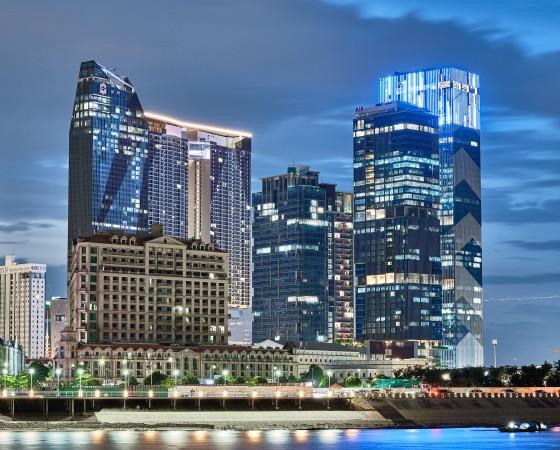
Overview of Phnom Penh
History & Cultural Influence
Phnom Penh, founded in 1372, has a rich history that reflects its significance as the capital of Cambodia and a cultural crossroads in Southeast Asia. The city became the national capital in 1434 after the fall of Angkor, and its name derives from the legend of Lady Penh, who discovered sacred Buddha statues along the river, prompting the establishment of the Wat Phnom temple. This historical backdrop has shaped Phnom Penh's character, making it a vibrant center of Khmer culture, with influences from its royal heritage and colonial past.
Culturally, Phnom Penh is a melting pot, showcasing a blend of Khmer, French, and Chinese influences, which is evident in its architecture, cuisine, and festivals.
Interaction with The Locals
When interacting with locals in Phnom Penh, visitors can expect a warm and welcoming atmosphere, characterized by the city's diverse population, which includes Khmer, Chinese, Vietnamese, and other ethnic groups. The general attitude towards tourists is friendly, with many locals eager to share their culture and traditions, especially in markets and community spaces.
Learning a few basic Khmer phrases can enhance these interactions and show respect for the local culture. Visitors will find that engaging in daily activities, such as visiting the bustling markets or participating in local festivals, provides a genuine glimpse into the lives of Phnom Penh's residents. Additionally, the city's rich history and cultural heritage are reflected in its vibrant street life, making interactions with locals both enriching and memorable.

Royal Palace - © Dalbéra Jean-Pierre
Top attractions in Phnom Penh
Phnom Penh, the vibrant capital of Cambodia, offers a blend of historical and cultural experiences that captivate every traveler. From the grandeur of the Royal Palace and the spiritual richness of the Silver Pagoda to the poignant history preserved at the Tuol Sleng Genocide Museum, the city invites you to explore its unique heritage. Phnom Penh’s bustling markets, serene temples, and riverside charm make it a destination that beautifully balances past and present.
Royal Palace
Location: at the crossroads of Norodom Boulevard and Sihanouk Boulevard in the heart of Phnom Penh.
The Royal Palace, built in 1866, is a magnificent complex that serves as the official residence of the Cambodian monarchy. With its stunning Khmer architecture, the palace is a symbol of Cambodia's royal heritage. The grounds include the Throne Hall and the Silver Pagoda, where over 5,000 silver tiles adorn the floor, offering a glimpse into the opulence of Cambodia’s past.
Silver Pagoda (Wat Preah Keo)
Location: Within the Royal Palace complex, Phnom Penh
Located within the Royal Palace complex, the Silver Pagoda is a treasure trove of religious artifacts, including a life-sized gold Buddha. The pagoda’s name comes from the gleaming silver tiles that cover its floor, though many are now protected under carpets. It’s a must-see for those interested in the spiritual and artistic heritage of Cambodia.
Tuol Sleng Genocide Museum (S-21)
Location: Street 113, Phnom Penh
Once a high school, this building was repurposed into a notorious prison during the Khmer Rouge regime. Now the Tuol Sleng Genocide Museum, it stands as a powerful reminder of Cambodia’s dark history, with exhibits that tell the harrowing stories of the victims who passed through its walls.
National Museum of Cambodia
Location: Street 13, Phnom Penh
The National Museum of Cambodia houses the world’s finest collection of Khmer art and artifacts, spanning over a millennium. The museum’s beautiful architecture and tranquil gardens offer a peaceful setting for exploring Cambodia’s rich cultural heritage, making it an essential stop for history and art lovers.
Wat Phnom
Location: Street 96, Phnom Penh
Wat Phnom, perched on Phnom Penh’s only hill, is a significant Buddhist temple with a history dating back to 1373. It is considered the birthplace of the city and offers a serene atmosphere and panoramic views of the surrounding area, making it a perfect spot for reflection and sightseeing.
Choeung Ek Genocidal Center (Killing Fields)
Location: Choeung Ek, Phnom Penh (about 15 km from city center)
Located just outside Phnom Penh, the Choeung Ek Genocidal Center serves as a solemn memorial to the victims of the Khmer Rouge regime. Visitors can walk through the haunting grounds and visit the memorial stupa, filled with the skulls of those who perished, offering a deeply moving insight into Cambodia’s tragic past.
Central Market (Psar Thmei)
Location: Street 126, Phnom Penh
Central Market, with its iconic art deco architecture, is a bustling hub where you can immerse yourself in local culture. From fresh produce and clothing to unique souvenirs, the market is a vibrant spot to experience the sights, sounds, and flavors of Phnom Penh, offering something for every traveler.

Wat Phnom temple - © gather
Must-Try Dishes in Phnom Penh
In Phnom Penh, you’ll find a vibrant culinary scene where traditional Khmer flavors come to life. Don’t miss the chance to try Amok, a creamy coconut fish curry steamed in banana leaves, or Bai Sach Chrouk, a simple yet flavorful breakfast dish of grilled pork over rice. These must-try dishes offer a delicious introduction to Cambodia’s rich food heritage.
Amok
Dive into the flavors of Cambodia with Amok, the nation’s signature dish, where tender chunks of freshwater fish are bathed in a creamy coconut milk sauce infused with eggs, fish sauce, and palm sugar, all beautifully steamed in a banana leaf. This dish is a true embodiment of Khmer culinary tradition, offering a rich and unforgettable taste of Cambodia’s vibrant food culture.
Bai Sach Chrouk
Start your day like a local with Bai Sach Chrouk, a simple yet satisfying breakfast of succulent grilled pork laid over fragrant rice, paired with pickled vegetables and a warm, comforting broth. This dish captures the essence of Cambodian mornings—hearty, wholesome, and full of flavor.
Kuy Teav
Experience the warmth of a Cambodian morning with Kuy Teav, a delightful noodle soup featuring rice vermicelli swimming in a savory pork or beef broth, topped with crispy shallots and fresh herbs. Served with a squeeze of lime and a kick of chili, it’s the perfect way to start your culinary adventure in Cambodia.
Lok Lak
Savor the fusion of flavors with Lok Lak, a dish of tender stir-fried beef marinated in soy sauce, served with fluffy rice and crowned with a fried egg. The accompanying tangy lime and black pepper dipping sauce adds a zesty twist that reflects the blend of French influence and local flair in Cambodian cuisine.
Nom Banh Chok
Enjoy a true Cambodian classic with Nom Banh Chok, a refreshing dish of rice noodles drenched in green fish curry sauce and garnished with a medley of fresh herbs and vegetables. Often enjoyed as a breakfast staple, this dish is a celebration of the country’s love for fresh, vibrant flavors and its rich culinary heritage.
Fried Insects
For the adventurous foodie, Cambodia offers a daring delicacy—fried insects like crickets and tarantulas, seasoned and crisped to perfection by street vendors. This unique snack is more than just a novelty; it’s a crunchy, protein-packed taste of Cambodia’s resourceful and diverse food culture, perfect for those eager to try something truly different.
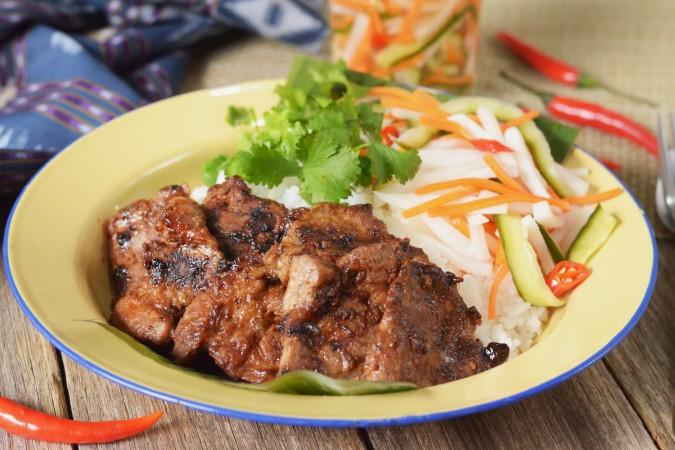
Bai Sach Chrouk - © gather
Weather patterns of Phnom Penh
Phnom Penh has a tropical wet and dry climate, characterized by high temperatures and humidity year-round. Here are the key details about its weather and climate:
Average Temperatures
Yearly Average: Typically ranges from 22°C to 35°C (72°F to 95°F).
Cool Season: November to February, with average temperatures around 24°C (75°F) during the day.
Hot Season: March to May, where temperatures can peak at around 40°C (104°F).
Rainfall
Annual Precipitation: Approximately 1,500 mm (59 inches), with most rainfall occurring during the rainy season.
Rainy Season: May to October, with the heaviest rainfall typically in August and September, leading to potential flooding.
Best Time to Travel
Optimal Travel Period: The best time to visit Phnom Penh is from November to February, during the cool and dry season when temperatures are more comfortable, and humidity levels are lower. This period is ideal for outdoor activities and sightseeing.
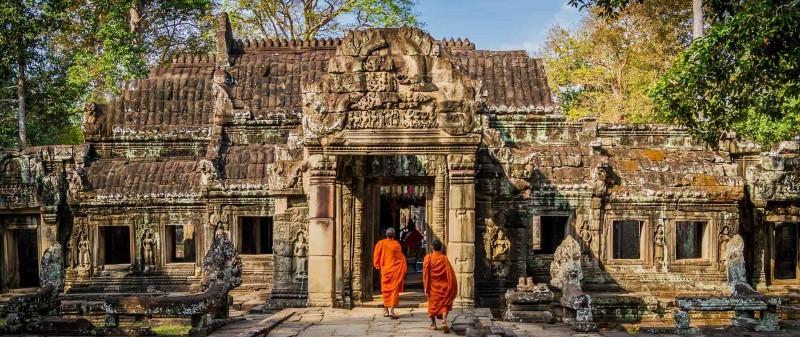
Best time to visit Phnom Penh - © gather
Essential Travel Information
Transport in Phnom Penh
Getting to Phnom Penh
Airport Transfers: Phnom Penh International Airport (PNH) is the largest airport in Cambodia, located about 10 km from the city center. Visitors can arrange airport transfers through services like Welcome Pickups and Suntransfers, which provide reliable and professional drivers to greet you upon arrival. The average cost for an airport taxi is around $12 for up to four passengers. Public transport options include city buses that connect the airport to various parts of the city, making it the cheapest option.
Public Transit
City Buses: Phnom Penh has a limited but growing public bus system with several routes, including air-conditioned buses that connect key areas of the city. However, punctuality can be an issue due to traffic conditions.
Taxis and Ride-Sharing
- Taxis: Taxis are widely available throughout Phnom Penh, and fares are generally affordable. It's advisable to negotiate the fare before starting your journey, as not all taxis use a meter.
- Ride-Sharing Services: While traditional ride-sharing apps like Grab may operate in Phnom Penh, they are less common compared to other Southeast Asian cities. However, they can be a convenient option for travelers familiar with the app.
Local Transportation
- Motorbike Taxis: For quicker travel around the city, motorbike taxis (known as "moto") are a popular choice. They are readily available and can navigate through traffic more easily than cars.
- Bicycle Rentals: Renting a bicycle is another way to explore Phnom Penh at your own pace, especially in areas with less traffic.
ATM and Banking Services
- ACLEDA Bank is a major bank in Phnom Penh that offers an extensive ATM network, with over 60 ATM locations across the city.
- ACLEDA ATMs are available 24/7 and allow customers to perform various transactions such as cash deposit, withdrawal, money transfer, and account management.
- Sathapana Bank also has a large ATM network in Phnom Penh, with over 340 ATMs across Cambodia that provide instant access to accounts.
Accommodation Choices
Phnom Penh offers a wide range of accommodation options to suit different budgets and preferences:
Budget Hotels
- Okay Guesthouse
- Seng Sokhom Guesthouse
- Billabong Hostel
Mid-Range Hotels
- Cardamom Hotel
- Frangipani Villa Hotel
- Aquarius Hotel & Urban Resort
Luxury Hotels
- Raffles Hotel Le Royal
- Sofitel Phnom Penh Phokeethra
- Rosewood Phnom Penh
Boutique Hotels
- Plantation Urban Resort and Spa
- Pavilion
- Amanjaya Pancam Suites
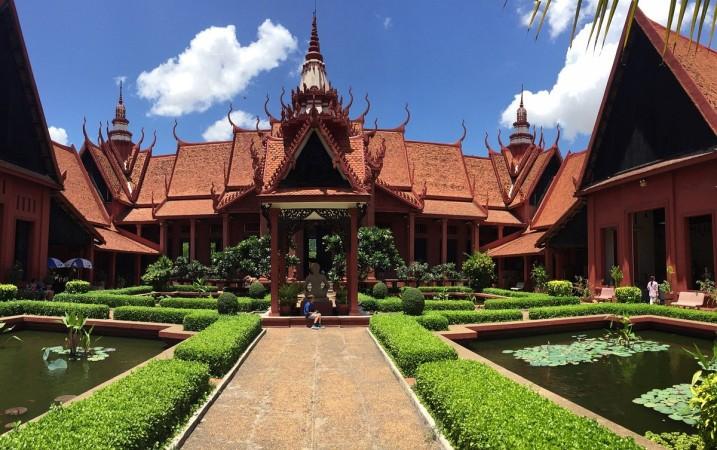
National Museum of Cambodia - © gather
Festivals & Local Celebrations
Khmer New Year (Chaul Chnam Thmey)
When: April 13-15
This is the most significant holiday in Cambodia, marking the end of the harvest season and the start of the new year. Visitors can experience lively street parties, traditional music, and water fights, as locals splash water on each other to symbolize cleansing and renewal. Temples are bustling with worshippers, and families gather to perform rituals and celebrate together.
Water Festival (Bon Om Touk)
When: November (dates vary according to the lunar calendar)
Celebrating the unique natural phenomenon of the Tonle Sap River's flow reversal, this vibrant festival lasts three days and features spectacular boat races, fireworks, and cultural performances. Thousands of locals and tourists flock to the riverside to enjoy the festivities, making it one of the largest and most colorful events in Phnom Penh.
Pchum Ben (Ancestor’s Day)
When: September or October (dates vary)
Deeply spiritual festival lasts for 15 days, culminating in the last three days known as Pchum Ben Day. Cambodians honor their deceased ancestors by visiting pagodas to offer food and prayers. Visitors can witness large gatherings at temples, where locals wear white clothing and participate in rituals, providing insight into Cambodian spirituality and respect for family ties.
Royal Ploughing Ceremony (Feast of Sowing)
When: May (date varies)
This ancient ceremony marks the beginning of the rice-planting season and is presided over by the King or a royal representative. Visitors can witness sacred oxen plowing a ceremonial field and choosing from trays of food, which are believed to predict the agricultural fortunes for the year. The event features traditional music and dance, showcasing Cambodia's royal traditions.
Constitution and Coronation Day
When: September 24
This national holiday celebrates the promulgation of the Cambodian constitution and the coronation of King Norodom Sihanouk. Visitors can expect various ceremonies and public events, including parades and cultural performances, reflecting the pride and resilience of the Cambodian people.

Royal Ploughing Ceremony Cambodia - © gather
Culture Etiquette in Phnom Penh
Greetings and Interactions
When greeting people in Cambodia, it's customary to use the sampeah, a traditional gesture where you press your palms together in a prayer-like position and bow slightly. The height of your hands shows the level of respect: for peers, hands should be at chest level; for elders or superiors, raise them to mouth level; and for monks or royalty, place them at forehead level. It's also polite to use honorifics—"lok" for older men and "lok srey" for older women. Public displays of affection are generally frowned upon, so it's best to avoid them.
Dress Code
Dressing modestly is important in Cambodia, especially when visiting temples or religious sites. Be sure to cover your shoulders and knees to show respect. You’ll also need to remove your shoes before entering homes, temples, or some businesses. Revealing clothing, like short shorts or tight-fitting outfits, is best avoided in public spaces.
Temple Etiquette
When visiting temples, remember to speak softly and behave respectfully. Never touch or point at Buddha images, and women should avoid touching or handing items directly to monks. Temples are sacred spaces, so it's essential to maintain a respectful and calm demeanor.
Body Language
In Cambodian culture, the head is considered the most sacred part of the body, so it's best to avoid touching anyone’s head, including children. On the flip side, feet are seen as the lowest part of the body, so don’t point with your feet or show the soles to others. When giving or receiving items, use your right hand, as the left hand is associated with personal hygiene.
Social Customs
When entering someone’s home, it’s customary to remove your shoes as a sign of respect. Cambodian society places great emphasis on respecting elders, so always show deference to older individuals. It’s also wise to avoid discussing sensitive topics, especially those related to the Khmer Rouge era.
Dining Etiquette
When dining with locals, wait for the host to start eating before you dig in. Cambodians often use a spoon and fork for meals—hold the spoon in your right hand and the fork in your left. If you’re using chopsticks, never stick them upright in your rice, as this mimics incense sticks used at funerals.
Photography
Before taking photos of people, especially monks, always ask for permission. Also, be mindful not to photograph government buildings or military installations, as this is generally prohibited.
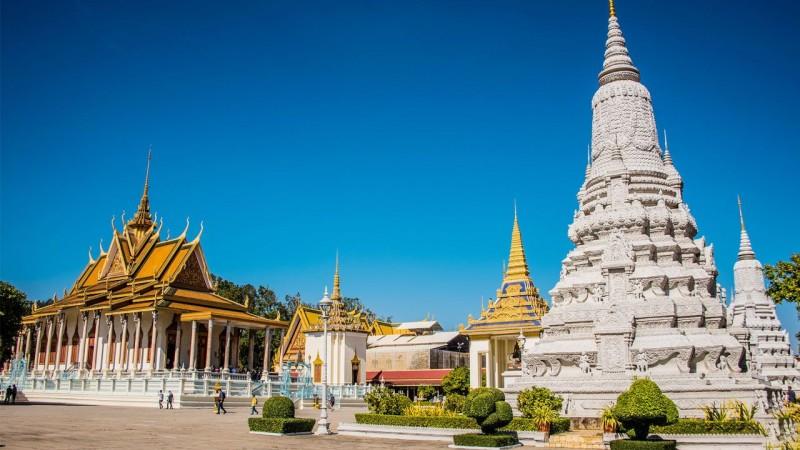
Silver Pagoda - © gather
Shopping in Phnom Penh
Phnom Penh offers a diverse range of shopping experiences, from traditional markets to modern malls. Here are some top recommendations for shopping, especially for local crafts and souvenirs:
- Central Market (Phsar Thmei): Located in a distinctive art deco building, this market is excellent for souvenirs, jewelry, and electronics. It's particularly good for gold and silver jewelry, as well as traditional Khmer crafts.
- Russian Market (Psar Tuol Tom Pong): This bustling market is popular among tourists and locals alike. It's a great place to find clothing, accessories, handicrafts, and souvenirs. The market is known for its maze-like alleys filled with various goods.
- Street 240: This charming street behind the Royal Palace is lined with boutique stores, cafes, and shops selling unique items. It's an excellent place for finding handcrafted goods, textiles, and products from local artisans and NGOs supporting fair trade.
- Artisan Designers (A.N.D): Located on Street 240, this shop showcases handcrafted goods made by disabled and disadvantaged artists, including indigenous minority groups. It's a great place to find authentic Cambodian art and textiles.
- Night Market: Open in the evenings, this market offers a lively atmosphere and a variety of stalls selling clothing, handicrafts, artwork, and street food. It's an excellent place to experience local culture while shopping.
- Aeon Mall: For a modern shopping experience, this mall offers a mix of international brands and local shops. While not focused on traditional crafts, it can be a convenient place to find a variety of goods.
- Tuol Tompoung Market: Often referred to as the Russian Market's little sister, this local market is known for clothing, accessories, and traditional Khmer silk.
- Watthan Artisans: Another store supporting disabled artists, offering a range of handcrafted Cambodian goods.
Articles for you

Explore Yala National Park - Sri Lanka Travel, Asia
Tucked away in Sri Lanka’s southeastern corner, Yala National Park is where wild nature meets deep tradition. Known worldwide for its leopard population, the park is also home to elephants, sloth bears, crocodiles, and hundreds of bird species. Beyond wildlife, Yala opens doors to a cultural landscape dotted with ancient temples, Buddhist ruins, and coastal villages. For travelers seeking more than just a safari, Yala offers a chance to explore eco-tourism, local communities, and sacred heritage sites.
Population: The Yala National Park area doesn’t have a human population.
Economy: The economy around Yala National Park thrives on a blend of eco-tourism, agriculture, and local services. Safari tours, eco-lodges, and cultural experiences drive steady income for nearby towns like Tissamaharama and Kataragama, supporting thousands of families.
Landmarks: Famous for Block I of Yala and wildlife encounters, including elephants, sloth bears, crocodiles, and exotic bird species.

Explore Galle - Sri Lanka Travel, Asia
Nestled on Sri Lanka’s southern coastline, Galle is a vibrant city where history meets the sea. Its cobbled streets, colonial architecture, and serene beaches make it a must-visit destination for travelers seeking a blend of culture, adventure, and relaxation. A UNESCO World Heritage site, Galle captivates visitors with its Dutch Fort, bustling markets, and friendly locals. Whether you’re exploring the ramparts at sunset or savoring fresh seafood by the shore, Galle promises an unforgettable journey into Sri Lanka’s heritage.
Population: Approximately 113,000 in 2023.
Economy: Galle’s economy thrives on tourism, trade, and fisheries. The city’s historic fort, colonial architecture, and coastal charm draw thousands of international visitors each year, making tourism its main economic driver. Fishing remains vital for local livelihoods, supplying fresh seafood across the region.
Landmarks: Famous for the Galle Fort, Dutch Reformed Church & Maritime Museum, and Unawatuna Beach.

Explore Bentota - Sri Lanka Travel, Asia
Nestled along Sri Lanka’s southwestern coast, Bentota is a tropical paradise that blends golden beaches, vibrant culture, and thrilling adventures. Famous for its calm waters, luxury resorts, and scenic river estuary, Bentota has become a top destination for travelers seeking both relaxation and authentic experiences. From serene beach walks at sunrise to adrenaline-pumping water sports, this coastal town offers a perfect balance of leisure and exploration. With its proximity to Colombo and Galle, Bentota is easy to reach, making it an ideal stop for both short escapes and extended holidays.
Population: Approximately 37,000 in 2023.
Economy: Bentota’s economy thrives mainly on tourism, which drives local businesses such as hotels, restaurants, and wellness retreats. The town also benefits from fishing, coconut cultivation, and handicrafts like wood carving and batik textiles. Many residents rely on the growing demand for water sports and Ayurvedic treatments, making tourism the backbone of both income and employment in the area.
Landmarks: Famous for Bentota Beach, Bentota River Safari, and Kande Vihara Temple.

Explore Mirissa - Sri Lanka Travel, Asia
Mirissa is a charming coastal town on Sri Lanka’s southern shoreline. Known for its golden beaches, turquoise waters, and vibrant marine life, it has become a must-visit stop for travelers exploring the island. Many come for whale watching, surfing, and sunset views at Coconut Tree Hill, but Mirissa offers much more than postcard beauty. The fishing boats you see anchored by the bay carry generations of stories. Local traditions, delicious cuisine, and a laid-back rhythm of life shape every visitor’s experience.
Population: Approximately 4,700 in 2023.
Economy: Mirissa’s economy is largely shaped by its coastal location. Fishing has long been the backbone of local livelihoods, with generations relying on the Indian Ocean for income. In recent decades, tourism has become the main driver of growth, thanks to whale watching, surfing, and beachside hospitality.
Landmarks: Famous for Mirissa Beach, Coconut Tree Hill, and Parrot Rock Bridge.

Explore Nuwara Eliya - Sri Lanka Travel, Asia
Tucked away in the Central Highlands of Sri Lanka, Nuwara Eliya is often called “Little England”. With its rolling tea plantations, cool misty mornings, and colonial charm, this mountain town feels like a step into another world. Travelers come here to breathe fresh air, walk through flower gardens, sip the finest Ceylon Tea, and enjoy a pace of life far from the island’s busy cities. Whether you’re drawn by scenic landscapes, heritage architecture, or the warmth of its people, Nuwara Eliya is a destination that blends nature, culture, and history in perfect harmony.
Population: Approximately 781,000 in 2023.
Economy: Nuwara Eliya’s economy thrives mainly on tea production, as it sits in the heart of Sri Lanka’s central highlands, famous worldwide for Ceylon Tea. The city also benefits from a growing tourism industry, attracting visitors with its colonial charm, cool climate, and scenic landscapes.
Landmarks: Famous for Gregory Lake, Hakgala Botanical Garden, and Victoria Park.

Explore Sukau - Malaysia Travel, Asia
Nestled on the banks of the Kinabatangan River in Sabah, Malaysian Borneo, Sukau is a destination where wildlife, culture, and conservation come together. Known as one of Asia’s top spots for river safaris and eco-tourism, this quiet village offers a front-row seat to encounters with Bornean orangutans, pygmy elephants, proboscis monkeys, and exotic birdlife.
Population: Approximately 1,400 in 2019.
Economy: Sukau’s economy is shaped by its riverine location and natural resources. Traditionally, the Orang Sungai community relied on fishing, small-scale farming, and forest gathering for their livelihood. Today, the village has shifted toward eco-tourism, with river cruises, jungle trekking, and homestays providing income.
Landmarks: Famous for the Kinabatangan River cruises, Gomantong Caves, and Ox-bow lakes and wetlands.
